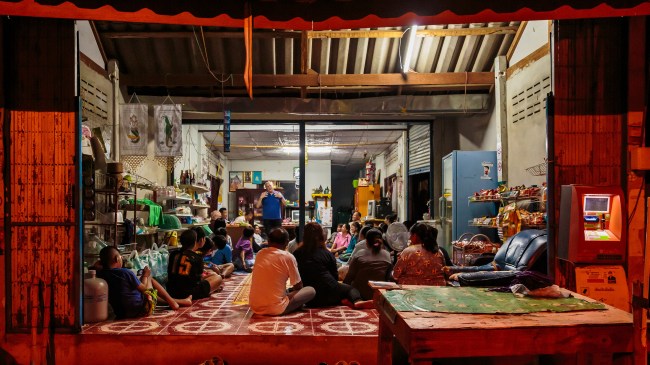Dwight Martin can tell you the exact number of churches in Thailand. At the start of 2019, his site reported 5,805. By the next week, the number would be different.
While missionaries overseas, and even Western churches, often rely on broad estimates, he can calculate exactly how many subdistricts in the Buddhist kingdom have no churches at all (5,509) and how many people live in communities without any Christian neighbors (62.5 million).
The American missionary-kid-turned-IT-guru oversees the most comprehensive national church database in the world, with corresponding maps indicating exactly which corners of the colorful Southeast Asian country are most desperate for the gospel.
Fluent in Thai from his childhood, Martin had presented his findings dozens of times to church leaders and missionaries over more than a decade serving as the official research coordinator for the Thai church.
When he initially shared the data with the founders of a growing Thai church-planting movement, they balked, wondering why a white man was trying to make them feel bad about the outlook for the church in their country.
But the Free in Jesus Christ Church Association (FJCCA) eventually invited Martin to give his presentation to 60 of their top leaders, a third of whom had converted to Christianity less than a year before. Once they saw Martin’s maps, with data drilled down to the village level, they realized just how unreached their own nation remained.
After 190 years of Protestant ministry in Thailand, 95 percent of 80,000 villages in the country still didn’t have a church. While their humble house church movement had begun to multiply across their province in Central Thailand, provinces all over the region—and to the east and to the south—had no growing gospel movement at all, many with a Christian population around 0.1 percent. So after Martin’s report, they did something the researcher had never seen before: Each church pledged, on the spot, how many people they’d lead to Christ before his next visit in about two months.
By the time Martin made his way back from Chiang Mai, where he lives in Northern Thailand, to the Phetchabun province, the FJCCA leaders had far exceeded their goals, starting 74 house churches and converting 782 people in just 54 days.
In 2018, FJCCA continued to bring in numbers that would confound most projections, statisticians, and historical trends. Then in January, the group baptized 520 new Christians in an outdoor service in Chon Daen. In the largest baptism national church leaders had ever seen, crowds waded chest-deep in a public reservoir with lush hills behind them.
In village after village, Thai people who had never before heard the name Jesus responded by the dozens to follow him. In a single day last December, 309 people began following Christ as FJCCA teams visited four villages for the first time.
 Wes Craft / Courtesy of Reach-a-Village
Wes Craft / Courtesy of Reach-a-VillageIt’s the fastest-growing church movement in the country’s history.
Founding pastor Somsak Rinnasak, a motorcycle mechanic and garage owner, has no seminary background or formal theological training. FJCCA converts start house churches in as little as six months and go on to plant “mother churches” in as little as a year.
Martin finally asked the pastors outright: “Who taught you how to do this?”
They didn’t understand the question. After a pause, Khun Rajirot, Rinnasak’s wife, responded, “We just read what Jesus and Paul did in the Gospels and Acts and do the same thing.”
The FJCCA’s church planting movement in Thailand represents a success story amid a shifting approach to global missions as Christians rely less on evangelism led by Western missionaries and instead trust the Spirit’s work among their own people.
Put simply, Martin said, “Thailand will be reached by the Thai.” FJCCA now plants more churches in two weeks than more than 300 evangelical missionaries with the Evangelical Fellowship of Thailand do in an entire year.
But while the growth itself may be a throwback to Acts, Martin’s use of data to track it is a distinctly 21st-century strategy that borders on disruptive—a reminder to Christians excited by the hype of mass evangelism events and urban missions that small-scale, off-the-grid evangelism can add up if you actually take the time to count it.
Reach A Village, a US-based ministry that supports Martin’s mapping work in Thailand and neighboring countries, promotes local Christians doing village-level outreach across Southeast Asia, where they’ve seen it lead to deeper discipleship and the gospel spread into communities with no previous Christian presence.
The goal is to see a church started in every village, just as Jesus himself went “to the nearby villages” to preach (Mark 1:38) and sent out his followers to do the same.
In Cambodia, churches have been planted in well over half of 14,000 villages, and Reach A Village founder Bob Craft believes they can reach every one within five years. Across Southeast Asia, the ministry’s partners have launched 6,500 new village churches over the past five years.
Shepherds Count Their Sheep
A software developer and former lay pastor under David Platt at The Church at Brook Hills, Martin returned in 2006 to the country where his parents were called to serve nearly 60 years before as the first Protestant missionaries to the Nakhon Phanom province in northeast Thailand.
His approach, in some ways, represents the literal next generation of missions. While his dad created paper maps by hand and his mother translated Scriptures from Greek to Thai, Martin built software that can populate searchable, color-coded maps dotted with every church in the country in a few clicks, and he runs a print-on-demand shop to create custom resources for new converts.
Despite being armed with modern technology and an array of data points, the motivation behind bringing “big data” into missions is a timeless one: to make disciples.
Martin and Craft see similar impulses in the accounts of Jesus’ ministry and the first apostles. New Testament authors care about place. They prioritize where events occurred, name-dropping the various cities and towns and villages where crowds gathered to hear the Good News.
“We just read what Jesus and Paul did in the Gospels and Acts and do the same thing.” ~ Khun Rajirot, wife of FJCCA founder
Certain passages also provide numbers—that someone must have counted up to have on record—for significant moments in the life of the church. The Gospels tell of the feeding of the 5,000, who were gathered in groups of hundreds and fifties, then the feeding of the 4,000. Acts offers some data points on church growth, from the initial 120 followers to the 3,000 added at Pentecost and the 5,000 who heard Peter and John preach.
Such details show the significance of both the big picture and the personal; though Paul visits nearly 50 places in the New Testament, in his epistles he greets individual leaders and members. As Craft put it, “Shepherds count their sheep, and they know them by name.”
Martin’s database, called Harvest, has been adopted by national church councils in Vietnam, Myanmar, and Laos, but is posted publicly in Cambodia and Thailand, where the threat of persecution isn’t high. The Church of Christ in Thailand, Evangelical Fellowship of Thailand, and the Thailand Baptist Convention—together representing more than 80 percent of Thai Protestants—use the findings to work together to reach their country, which is almost entirely Buddhist (94%).
 Wes Craft / Courtesy of Reach-a-Village
Wes Craft / Courtesy of Reach-a-Village“We feel that this is the gift from the Lord for the national plan of Thailand because [Martin] came at our time of need,” said the late Enoch Yuttasak Sirikul, who served as chair of the Thailand Evangelism and Church Growth Committee, the group formed by all three major councils, prior to his death in 2016. “It’s helped us to progress in doing evangelism and church planting.”
Denominational leaders and pastors access the Harvest database online to input information about their churches, which then appear as dots on a map, searchable by tradition, worship language, and province. The dots overlap in a huge clump at the top of the country around Chiang Mai, home to over half the country’s Christians but just 5 percent of the population—a carryover from concentrated missions efforts aimed at unreached minority people groups in the region. Another map, shaded green and tan, indicates the percentage of Christians in each province.
Besides the maps and directory publicly available at ThaiChurches.org, church leaders with the FJCCA track more detailed information in another system Martin set up, First Fruits. Using an Android app, they can record each new member’s gender, age, the dates of their profession of faith and baptism, their level of discipleship, and a photo.
These data points bring a human element to the big-picture trends in the numbers—the average convert in Thailand is a woman in her 50s, for example—and provide a sense of accountability over what happens to a new believer after they come to faith. Last year, over 10 percent of the 7,000 new believers in Thailand completed a second level of discipleship training.
“The focus needs to be back on finding these people and training them,” said Craft, who drills local partners for details on long-term discipleship plans and resources for converts (you can’t just grab a Bible, or anything close, when you live in places with no Christians at all). “If it’s just hands raised in a crowd, I don’t listen.”
The system has built momentum around the Thai church’s national plan for evangelism focused on unreached villages and has incentivized churches to accurately and regularly self-report.
Real-Time Results
The Thai research is the “most robust and ongoing” national Christian database in the world, according to Todd Johnson, director of the Center for the Study of Global Christianity at Gordon-Conwell Theological Seminary.
And though it would be difficult to replicate such a comprehensive setup in countries that already have sizable Protestant populations, ministries around the world are similarly looking to use their own real-time metrics to direct missions.
Today’s technology allows Christians to collect more information about where the gospel is going forth, and rather than waiting to report the news in a letter, like the apostles, or in printed resources, which take longer to compile and publish, they can share it with the body of Christ instantaneously.
An online database for Bible translators that launched three years ago, for example, lets organizations share progress on individual projects, languages, and locations, right down to the chapter and verse they’re working on.
“Bringing together information about plans, projects, and translated materials and then giving you the tools to dig deeper using maps, charts, and search, Progress.Bible provides a single point of reference to help you make sense of what’s going on,” declares a promotional video for the translation hub, created in partnership with Wycliffe Global Alliance, Every Tribe Every Nation, and United Bible Societies.
The information aggregated on Progress.Bible has already led to translation ministries partnering together on projects and training, sharing facilities, and working more effectively toward the goal of having a Bible project underway in every language by 2025.
 Wes Craft / Courtesy of Reach-a-Village
Wes Craft / Courtesy of Reach-a-Village“There’s greater chance for input from multiple organizations and churches that know things that others don’t,” said Andy Keener, Wycliffe Bible Translators’ director of global partnerships. “What we find now is that we know more than we ever have, and we’re learning more quickly than ever before.”
That knowledge also gets passed along to supporters, offering the transparency and connection that today’s donors crave. Wycliffe’s Facebook page shares its large-scale progress—like when it completed its 1,000th New Testament translation last year—as well as updates from translators and projects to pray for.
Numbers generated through databases, surveys, and other measures help capture where ministry needs are greatest, making it easier for organizations to identify shared Great Commission goals and work toward them together.
“You need good systems that can measure that [progress], otherwise you’re just telling the anecdotes,” said Tom Lin, president of InterVarsity Christian Fellowship. After collecting statistics from eight major college ministries, his organization determined that fewer than half of 2,500 major US campuses have a significant student ministry presence.
“We only found that out through data; otherwise you might assume, ‘Of course there’s campus ministry at every campus,’ ” he said.
To help improve their reach, this year InterVarsity and Cru launched EveryCampus.us, where Christians can pull up information about student ministry at schools in their area and log prayer walks on campus, sharing updates in real time. The site, which will also be available by app, displays which organizations have active chapters at each college, and how many users have prayed for the students there.
Spirit Led and Statistic Led
Access to up-to-date data, maps, and metrics, however, presents new tensions for ministry leaders who must consider how they see themselves at work versus how they see God at work. The statistics that inspire missions workers to chase after a Great Commission calling could also turn into idols. It’s easier for Christians to find their worth in the numbers.
“We acknowledge it’s the Lord who controls the outcome,” Lin said. “We have to be careful of the mindset that we control the outcome. But can we learn from what we’re doing? Yes.”
Metrics can drive more effective stewardship of time, people, and finances, but they’re often just one aspect of a bigger strategy. Many organizations see data capturing and amplifying where the Spirit is already at work.
When Wycliffe laid out its Vision 2025 in 1999, the goal was a stretch; translators were aiming to do in a generation tasks that would have taken more than a century at their current pace. But within the first five years, Keener said, they experienced a sense of urgency, and the work accelerated. About 1,600 language communities remain with no translation project.
“We need to challenge ourselves to think differently, act differently, relate differently, and then trust the Holy Spirit to move in the lives of the church worldwide,” he said. The use of the Progress.Bible hub and a growing reliance on native leaders and translators have allowed Wycliffe staff to play a more specialized role and get more done.
As a researcher, Johnson at Gordon-Conwell has created countless resources measuring the size and expanse of the global church—and he’s also seen how a deeper understanding of demographic data influences missions.
He recounted how once a Youth With A Mission leader in Australia began educating students about the least-evangelized places in the world, the students’ prayers for nations—marked by pins on a map—began shifting away from Western countries to majority-Muslim and majority-Hindu nations. “People’s knowledge affects their hearing of God’s voice,” Johnson said. “It isn’t simply a tabula rasa; there’s information there that’s moving people.”
Thai leaders experienced a similar shift two years ago, when Martin began calculating unchurched villages instead of just unchurched provinces and districts (a move spurred by Reach A Village). The new picture showed them that though more congregations were being planted, they weren’t reaching new parts of Thailand with the gospel; instead, many churches clustered in areas where there were churches already.
The FJCCA has used the national data not just as a catalyst for its multiplication, but as a directive to grow out, spreading village to village.
The origins of the movement date back to 1984, when Rinnasak—a second-generation believer who gave his life to Christ at 22—founded his first congregation in Chon Daen, since the nearest church was about 80 miles from his home. Over the years, the church went on to grow and split, eventually starting a handful of daughter congregations.
The FJCCA got a major boost in 2016, when it canceled a large-scale Christmas celebration in Chon Daen following the death of the king. By holding more than a dozen smaller events in surrounding villages to replace the single gathering, it had a bigger response than before, with 700 people coming to faith in 17 villages.
A largely grassroots movement, the FJCCA affiliates with the Evangelical Fellowship of Thailand, a Baptist and Pentecostal-leaning group that includes over 150 missions organizations and church associations.
 Wes Craft / Courtesy of Reach-a-Village
Wes Craft / Courtesy of Reach-a-VillageOut of 13 mother churches, FJCCA has added more than 400 house churches since 2016. Its biggest challenge has been training new leaders, who are tasked with continuing the work of evangelizing and church-planting. FJCCA focuses on a simple gospel presentation, prayer, and intimate fellowship, a model that converts can adopt and take to the next unreached village.
Rinnasak and fellow FJCCA leaders remove any “Christianese” from their phrasing, saying “Jesus bless you” rather than “God bless you” to specifically name the Christian God, and referring to believers’ “life experiences” rather than the more obtuse “testimony.” The association embraces the house church setting. When people convert in far-off villages with no Christian presence, it’s awkward and impractical for them to travel to existing congregations to learn and worship. Even once more mature churches move into buildings for Sunday worship, they still meet in homes as a more familiar location for discipleship.
Evangelists travel to villages with enough people ready to stick around to start the discipleship process. They share Bible stories and personal accounts to point to Jesus. Once people put faith in Christ, they invite them to pray right away for what they need, returning within a day or two to offer further training and materials from the Thailand Bible League, another partner.
Reach A Village noticed that the most effective church planters in the region share these distinctives. In Cambodia and Myanmar, the ministry also found that evangelism is “best carried out by local, indigenous believers and leaders who rely solely on the Scripture and the Holy Spirit with minimal outside interference or restrictions,” Craft said.
 Wes Craft / Courtesy of Reach-a-Village
Wes Craft / Courtesy of Reach-a-Village“Our ministry partner leader in Myanmar, Michael Koko Maung, once said to me, ‘Christianity came to us like a potted plant. We did not realize that when we took it out of the pot that it would grow so well in native soil.’ ”
FJCCA’s strategy is working, so much that Martin added a new staff member based in Phetchabun province dedicated to managing their figures. And he can barely keep up: Already, the movement has added 11,941 new believers in the past year and a half.
The Shifting Western Role
Craft wrestled with his role as a missionary in Thailand decades ago, comparing his potential impact to local believers who already knew the language and culture. “Am I worth what this guy is for kingdom impact?” he wondered, upon meeting a Bible teacher in the remote village he was sent to help evangelize.
Now he’s set up his organization to help meet needs identified by Thai leaders themselves. Reach A Village essentially provides gas money to village-level church planters—sometimes the literal dollar or two to cover the ride to the next village and sometimes more figurative “gas money” to fund day-to-day supplies like Bibles in their native languages, kids’ ministry texts, and other curricula. (Martin also runs a cheap print-on-demand service based in Chiang Mai, so church leaders can order just the amount they need.)
 Wes Craft / Courtesy of Reach-a-Village
Wes Craft / Courtesy of Reach-a-VillageMissions data helps all who are involved, from donors and churches to missionaries and ministries, to identify where they can contribute and ensure their efforts are making a difference.
Halfway around the world from Phetchabun province, a megachurch pastor in Washington State heard about what he called an “Acts 1 and 2 movement of God happening in a Buddhist stronghold.” Grant Fishbook of Christ the King Community Church ended up connecting with Somsak, the FJCCA founder, through Reach A Village.
Fishbook knows that the $75,000 his congregation donated toward church planting in Thailand (matched by another partner church) will bear gospel fruit; the ministry data continues to document the growth day by day. He also traveled there last year to observe its impact in person, visiting a half-dozen FJCCA house churches, packed with about 50 believers each.
“The world has shifted and changed. I believe the day of the great white missionary is gone,” said the American pastor, who remembers the new converts sharing stories of the miracles they experienced since coming to Christ. “God was so unbelievably active in these other parts of the world.”
Fishbook sees his role as supporting and encouraging the local leaders making evangelism happen in unreached places. At Christ the King, his congregation gets to partner, pray, and celebrate the story of the Great Commission going out in the 21st century.
Data best serves missions not by “cracking the code” to scoring converts or automating processes but by spurring relationships like these—between Martin the researcher and Rinnasak the pastor, or between FJCCA house churches in Central Thailand and a multisite megachurch in northern Washington.
Frustrated by ministries that continue to use vague estimates or outdated statistics, Martin carved out his own unique contribution as a missionary, bringing his IT background to serve the national church. He built the database platform because he believes evangelists deserve the best information for the task at hand. As FJCCA’s numbers tick up, he proudly shares stats of each batch of converts on his Facebook page.
He knows that each tally represents another soul saved—and if trends continue, potentially another house church leader, another mother church leader, another piece of a movement that, through the work of the Spirit, has filled in his once-sparse maps of Thailand.
Kate Shellnutt is associate online editor of Christianity Today.
Was this article helpful? Did we miss something? Let us know here.














